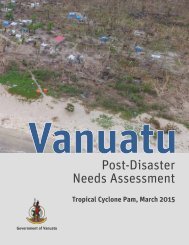Fiji
yqgk302EGjo
yqgk302EGjo
Create successful ePaper yourself
Turn your PDF publications into a flip-book with our unique Google optimized e-Paper software.
FIJI Post-Disaster Needs Assessment<br />
Different social groups have been affected in distinct ways by TC Winston. Housing serves different functions for different<br />
household members. For example, due to their role in reproductive work and lack of access to jobs in the formal economy,<br />
women often derive income in their homes. Men, on the other hand, use homes for resting and recuperating, and their<br />
economic activities tend to not be home based. For example in Ra and Tailevu (Western and Central Divisions respectively),<br />
most women were engaged in mat and basket weaving at home 94 before the cyclone; however, since the cyclone,<br />
their economic activities have come to a halt due to the destruction of houses, kitchens, raw materials and equipment.<br />
Destruction of homes could, therefore, have more far-reaching consequences for women than men. Homes are places for<br />
nurturing and security for children, and loss of housing is likely to compound the traumatic experience of having endured<br />
a Category 5 cyclone (as noted in Chapter 3.2.2 of this PDNA, which considers the effects of TC Winston on the health<br />
sector). Housing also offers shelter and security for women and young girls from potential violence. While most families<br />
have returned home and are no longer in emergency shelters, many are still seeking shelter with relatives and friends while<br />
waiting to rebuild their homes. Therefore, the lack of access to privacy, and cramped living arrangements with extended<br />
family and friends, can lead to increased vulnerability for exploitation and put women and girls at a heightened risk of sexual<br />
and physical violence.<br />
Such risks are also high for households headed by women who are still living in transitional shelters. Female-headed<br />
households make up about 12 percent of all <strong>Fiji</strong>an households. Assuming that approximately 12 percent (or 3,529) of total<br />
houses destroyed belong to female-headed households, such households would incur total damage and losses in excess<br />
of F$93 million. While female-headed households are usually economically better off than male-headed households, 95<br />
statistics show that female-headed households, where the head is divorced or has never married, have a 71 percent<br />
higher poverty rate, making them susceptible to severe disaster impacts, livelihoods stress and poverty. 96 Homes headed<br />
by single women are, therefore, more likely to be poorly constructed and maintained and, accordingly, to have sustained<br />
extensive damage from TC Winston. Furthermore, households belonging to widows, the elderly, PLWD and single women<br />
may also struggle to rebuild their homes due to a lack of physical strength and/or resources to rebuild quickly.<br />
Home reconstruction programmes should prioritize the most vulnerable households to ensure they have access to resources<br />
to build their homes. The Help for Homes initiative should ensure that the targeting and verification of beneficiaries reaches<br />
the most vulnerable households. The appropriate share of the allocated F$70 million should reach all households that<br />
earn less than F$50,000 a year, including single women, divorced women and widows, PLWD and the elderly, as these<br />
groups are often among the poorest. The data used by the PBS managed by the Ministry of Women, Children and Poverty<br />
Alleviation could be a starting point in identifying the poorest households. Both women and men must also participate and<br />
benefit from home reconstruction programmes. As such, training women in masonry skills to support home construction<br />
could also assist women, who are underrepresented in the labour force, augment their livelihoods.<br />
Recovery and Reconstruction Needs for the Housing Sector (F$857 million)<br />
Early recovery of <strong>Fiji</strong>’s housing sector began through the efforts of private households assisted by government agencies,<br />
the private sector, NGOs and other donors within a week after the cyclone. This included clearing debris in the villages and<br />
salvaging materials for housing and other building repairs.<br />
The government established a dedicated CIU in the Ministry of Finance’s SPO to coordinate the preparation of a recovery<br />
strategy in the housing and other sectors. The CIU has received a wealth of voluntary support from <strong>Fiji</strong>’s private sector,<br />
notably from members of the FIE and from NGOs through the Shelter Cluster, providing detailed technical costing and<br />
recommendations for the future.<br />
On April 9, 2016, H.E. Prime Minister Frank Bainimarama announced the Help for Homes initiative, which is at the core of<br />
the housing reconstruction strategy; an initial amount of F$70 million from the government’s 2016 budget was announced<br />
at the strategy’s launch. The Help for Homes reconstruction strategy recognizes that households are responsible for<br />
rebuilding and repairing their own homes. However, in order to ‘jump start’ private households’ resources, the government<br />
will provide a construction materials grant to every affected household earning less than F$50,000 97 according to the level<br />
of damage. Three grant amounts will be offered as shown in Table 48.<br />
94<br />
Based on interviews conducted by the Department of Social Protection, ILO, UN Women and UNDP on 13 April 2016.<br />
95<br />
This is largely due to the fact that most female-headed households are supported by migrant spouses who sent remittances.<br />
96<br />
<strong>Fiji</strong> Bureau of Statistic 2011: Republic of <strong>Fiji</strong> Poverty Trends, Profiles and Small Area Estimation (poverty maps) in Republic of <strong>Fiji</strong> (2003-<br />
2009).<br />
97<br />
According to the limited available income information (HIES 2008/2009), the average annual income was F$23,000 for urban households<br />
and F$11,068 for rural households. Therefore, almost all affected households are expected to be eligible to receive a materials grant.<br />
76 Tropical Cyclone Winston, February 20, 2016



